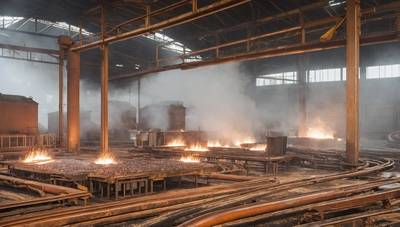Andy Home: Copper smelters face both a market and pricing crisis.
Copper smelters have become so desperate for raw materials that they pay miners to convert their concentrates into refined copper.
The so-called treatment-and-refining-charges (TCRC) are supposed to be a major revenue source for copper smelters, but the spot charges have been in the negative since the beginning of the year.
The copper bull narrative is that there are too few mines. However, the current collapse in processing fees can be attributed to too many smelters and too much demand.
The imbalance is unsustainable, especially if the smelters accept to pay a negative amount for the mid-year discussions, which established the price for volumes much higher than those on the spot market.
Copper industry pricing concentrations that are done annually or semi-annually is also unsustainable.
ACID LIFELINE
Smelters can rejoice that spot treatment costs have stopped dropping. Benchmark Mineral Intelligence reports that spot treatment charges have not done more than stabilize at $-45 a ton and -4.5 cts per lb.
Smelters who chose to lock-in tonnages for the entire year are partially protected, but this year's benchmark term of $21.5 per tonne was also the lowest since at least 20 years.
Mid-year negotiations are likely to produce a lower result, but smelters may balk at a TCRC that is negative for contracts which could extend into 2026.
The smelters are able to survive financially by producing valuable by-products, such as silver and gold. Smelters also produce sulphuric acids, which are in high demand in China due to the phosphate fertiliser industry.
Copper should be the main source of revenue for a copper smelter, but that is not what we are seeing.
Too Many Smelters
The mines are not denying that production has increased. According to the International Copper Study Group, global output increased by 2.1% in 2020, 2.8% by 2024, and another 1.2% by the first quarter this year.
China's copper concentrate imports are on the rise. They reached a record 28.2 millions tons of bulk weight in 2018 and grew 7.5% from year to year during the first four month of 2025.
The problem is that Chinese smelting capacities have been built up too fast, and newcomers are chasing the available tonnage.
The scrap is an alternative source of feed for some, but the market is becoming more competitive and Chinese imports are flat this year compared to 2024.
In China's refined metal production, the rapid expansion of processing capacity can be seen. According to the National Bureau of Statistics, May's output increased by 14% compared to last year.
Shanghai Metal Market, a local data provider, estimates that production has increased by 11% this year compared to 2024.
Some Western smelters are already closing due to the squeeze on margins.
In February, Glencore put its Pasar smelter located in the Philippines into care and maintenance. Sinomine has done the same at its Tsumeb facility in Namibia.
Chinese operators appear to be intensifying their efforts in what is a strategy of the last man standing.
BREAKING POINT
China's increased smelting capability will not allow the world's mines to increase their collective output to the same extent.
The raw materials supply chain will only get more stressed as new smelters are built in Indonesia. This will end the country's position as a major supplier of concentrates to Asian smelters.
It is inevitable that something will give, especially since the Chinese copper market demand is expected cool down due to the reduction of subsidies in the solar panel industry.
It could be some time before more capacity is closed to correct the current imbalance between supply and demand.
This puts more pressure on the price-discovery process in the industry, which is still based on annual deals.
In China, there has been some movement toward quarterly pricing or even spot pricing.
Smelters have learned that a negative annual price can be a serious problem. A mid-year negative deal is a bad precedent.
Iron ore markets, for example, have moved away form annual benchmarks that could not capture price volatility on the spot or sudden changes in supply dynamics.
CME contracts are now available for the hedge of lithium, a commodity that is widely perceived to be too unique for standardised futures.
Copper smelters may need to rethink their pricing strategy in the processing chain. They are literally handing money to miners.
The author is a columnist at
(source: Reuters)
